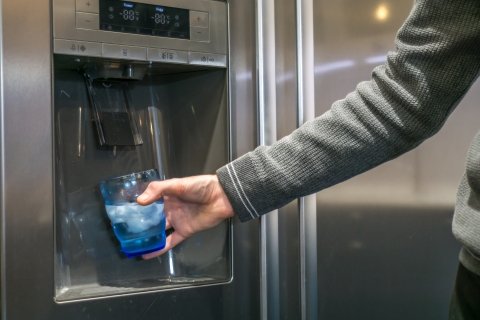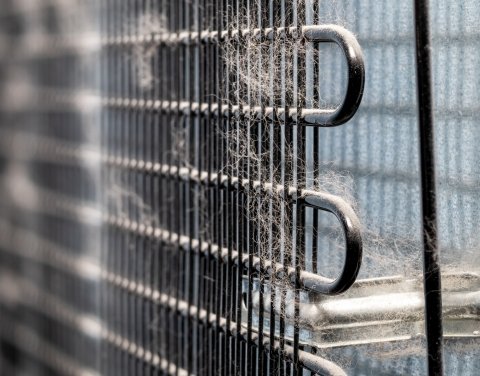Replacing old appliances can be one of the easiest and most effective ways to update a home for energy efficiency. Replacing your old refrigerator could save you money on your energy bills.
If you are not certain whether replacing your current refrigerator is necessary, go to the ENERGY STAR Flip Your Fridge Calculator to find out how much that old refrigerator or freezer costs to operate and how much you can save by flipping it to a new ENERGY STAR-certified refrigerator.
Why ENERGY STAR-Certified Refrigerators?
ENERGY STAR-certified refrigerators or coolers can maximize energy and dollar savings without sacrificing the features. ENERGY STAR-certified refrigerators are about 9 percent more energy efficient than models that meet the federal minimum energy efficiency standard. New ENERGY STAR certified-refrigerators can save more than $220 over a 12-year lifetime. ENERGY STAR-certified coolers - also known as wine coolers and beverage centers - are 10-30% more efficient than models that meet the federal minimum energy efficiency standard.
ENERGY STAR-certified refrigerators offer high performance features such as high-efficiency compressors that create less heat and use less energy, improved insulation that helps food stay cold, and temperature and defrost mechanisms that help the refrigerator operate more efficiently.
Refrigerators that are recognized as ENERGY STAR Most Efficient deliver cutting edge energy efficiency along with the latest in technological innovation. They represent the very best for energy savings and environmental protection.
When purchasing an ENERGY STAR refrigerator, here are some helpful buying guidance to optimize performance and savings:
- Be sure to select the right size for the household's needs. A refrigerator that is too large wastes energy. The most energy-efficient models are typically 16-20 cubic feet. Generally, the larger the refrigerator, the greater the energy consumption.
- Models with the freezer on top tend to use less energy than those with freezers on the bottom or side-by-sides.
- Refrigerators with fewer doors reduce the air leakage. To maximize your savings, minimize the number of doors and pay attention to cool air you can feel when you shut the doors. Make sure the seals around the doors are airtight. If they are not, replace them.
- Consider selecting an ENERGY STAR-certified refrigerator with a lower Global Warming Potential refrigerant (GWP). Refrigerants with lower global warming potential (GWP) for refrigerators, such as R600a and R-441A, means your product will have a much lower impact on the climate if the refrigerant is released into the environment.
- Don’t keep the old refrigerator as a second refrigerator. On average, an old refrigerator uses about 35% more energy than a model that has earned the ENERGY STAR label. If second refrigerator is truly needed, purchasing a larger refrigerator for the extra room will save money and energy over the long term..
- Be certain to properly recycle the old refrigerator. When delivering a new refrigerator many appliance retailers will pick up and recycle that old refrigerator.
In-the-door ice and water dispensers have become common on refrigerators. In fact, it can be hard to find a model that doesn't offer this feature. A dispenser can be a nice convenience as it offers cleaner and better tasting water and ice because of built-in filters.
However, refrigerator freezers with in-the-door ice and water dispensers typically cost more than comparable models without the feature, and annual operating costs tend to be higher as well, due to the extra electricity needed to power the unit and the cost of replacement filters. Another drawback to in-the-door ice and water dispensers is that the icemaker and water filter reduces the amount of usable storage space in many models.
Maintaining An Energy Efficient Refrigerator
Routine maintenance is important for refrigerators. Dirt should be cleaned from the refrigerator coils every six months to a year - more often if there are shedding pets in the home.
When coils are dirty with lint, dust, or pet hair, the refrigerator has to work harder than it’s designed to, which can prevent the appliance from cooling properly and efficiently. This can increase the energy cost of the refrigerator by as much as 35% and shortens the life of the refrigerator.
Also, keep the refrigerator or freezer away from direct heat. Place the refrigerator or freezer away from direct sunlight and other heat sources such as ovens or ranges. Heat will cause the unit to use more energy to stay cold.
Do not forget to regularly change the water filter, if the refrigerator has an in-the-door ice and water dispenser, and the air filter which now come with many models.
Subscribe to receive updates from Energy Saver, including updated content and energy saving tips for consumers and homeowners.



